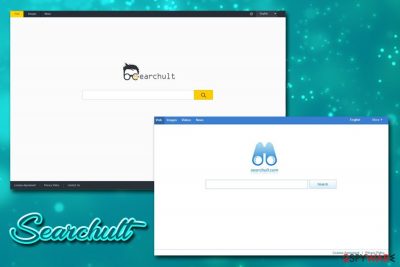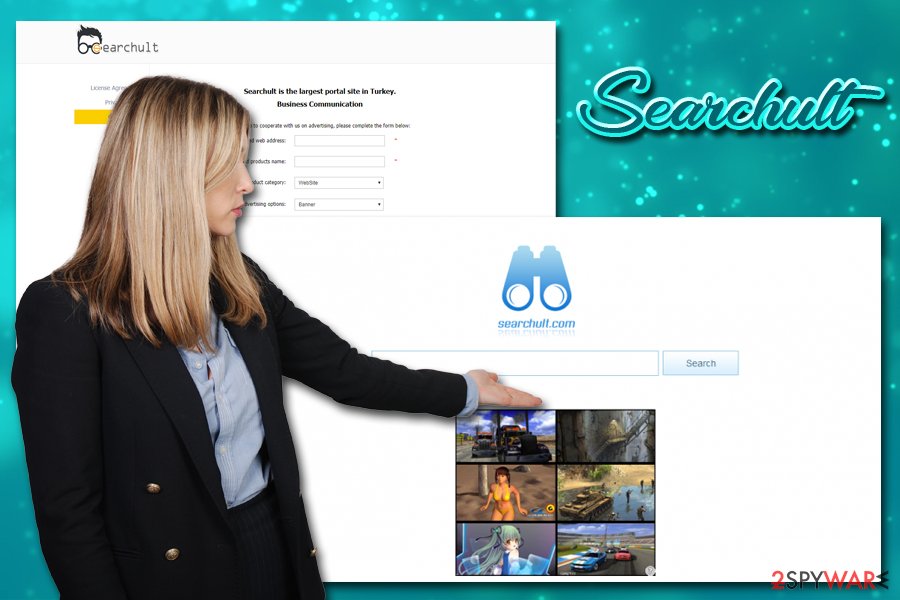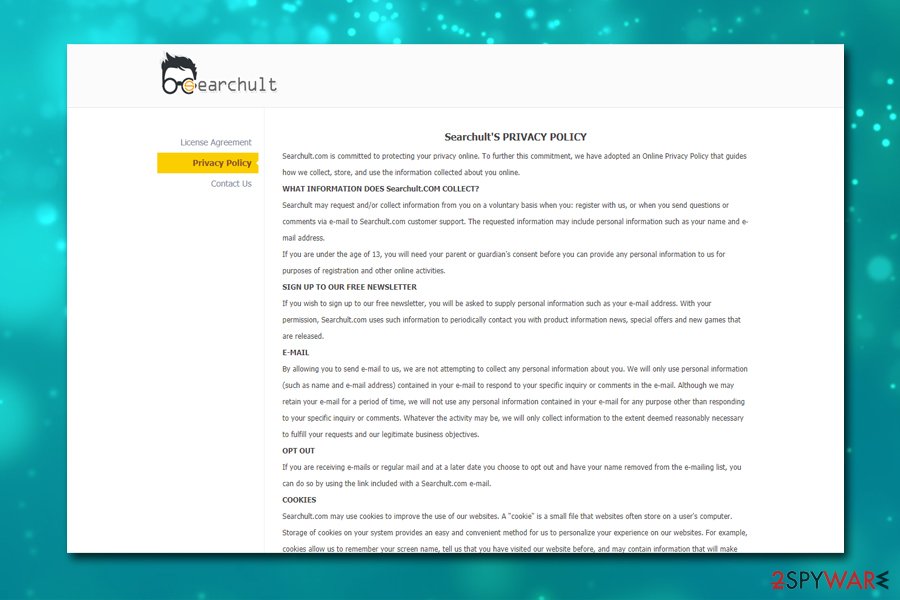Searchult (Removal Instructions) - Jul 2019 update
Searchult Removal Guide
What is Searchult?
Searchult is a browser hijacker that can enter the computer unexpectedly and change web browser settings without asking

Searchult is a questionable search engine that changes default settings of Google Chrome, Internet Explorer, Safari, Mozilla Firefox, or another browser and sets homepage to Searchult.com. Due to these modifications to web browsers, the program is categorized as a browser hijacker[1] – one of the potentially unwanted program types.
Unwanted applications like Searchult enter machines without users' direct approval, as they are often included in software bundles that are hosted on third-party sites. Nevertheless, PUPs can often be downloaded from their official websites or other legitimate sources, such as Chrome web store. Despite that, it does not mean that the application is beneficial and that it is entirely safe to use.
While Searchult hijack is not as dangerous as ransomware or other serious malware infection, you should not ignore it. It might bring you to sites that offer bogus software, spy on your web browsing habits and spam most sites that you visit with ads.
| Name | Searchult |
| Type | Browser hijacker |
| Category | Potentially unwanted program |
| Distribution | Software bundling, third-party sites, ads |
| Symptoms | Changed web browser settings, intrusive ads, sponsored links, etc. |
| Risks | Installation of other unwanted software, loss of money |
| Termination | Delete unwanted programs with anti-malware software like FortectIntego or use our manual removal guide below |
After changing web browser settings, Searchult will take over your search results, as they will be redirected to Yahoo. However, unlike the legitimate version of Yahoo, users will see many sponsored links that lead to predetermined websites. These are the links that third-parties paid for, and sometimes might not be exactly useful or even safe.
This is why Searchult removal is recommended, especially if the hijack happened without your consent. Be aware that the unwanted program might also have injected your desktop shortcuts and the Start Menu with its own argument – a technique that can be used for PUP persistence.
Besides sponsored links and ads, Searchult virus victims might sometimes face multiple redirects once they enter an unsafe site. This activity might be especially dangerous, as the endpoint of rerouting is not known, which means that you might end up on malware-laden or hacked sites that could infect your PC with worms, rootkits,[2] trojans, or other dangerous malware. Nevertheless, such a scenario is less likely, especially if you use security software with real-time protection feature.

Another reason to remove Searchult hijacker is due to its data-gathering activities. The unwanted program might collect a variety of information about you in order to serve you targeted ads. For example:
- IP address
- Geolocation
- Search queries
- Links clicked
- Sites visited
- Bookmarks added, etc.
The aggregated data is then shared with third parties for more profits. As technology is moving forward, data is one of the most valuable assets in the marketing business, so there is no surprise there that cookies and other tracking technologies are used in order to harvest it.
You can uninstall Searchult by following our step-by-step guide below or by employing reputable anti-malware software. We recommend using FortectIntego, although other tools that specialize in potentially unwanted programs can be used as well.
Browser hijacking applications should be avoided
Browser hijackers are considered to be a minor computer threat, as browsers now became smarter and are more resistant to such infections (along with online scams that lurk the internet). Nevertheless, it does not mean that you should let them into your machine every time you install new software, as PUPs tend to modify web browser settings, and, even if you not likely to end up with malware on your device, resetting these settings each time can be frustrating.
You may be tricked into downloading the unwanted application on your computer when downloading various download managers, PDF creators, video streaming software, and similar programs. Fortunately, you don't have to be a PC expert if you want to avoid infiltration of browser hijackers or other potentially unwanted programs.
You need to be more careful when selecting freeware and also dedicate more time for its installation. First of all, you should check out reviews online – these can often indicate if the app has any fishy features that are not instantly disclosed. If everything looks fine, then start the installation of the program that you need.

Before you finalize the process, you should pick Custom or Advanced installation option that allows seeing what “optional” components are trying to get inside the system. If you find a checkmark stating that you agree to install plugins, add-ons or extensions, or that you agree to change your default search engine, you should remove them ASAP.
Remove Searchult from your computer and clean your browsers
If you are bothered by Searchult redirects, annoying pop-up ads,[3] and similar inconveniences, you should waste no time and get rid of this browser hijacker that is hiding in your computer and causing these issues. For that, you can choose from manual or automatic option – pick the one that suits you best.
In some cases, Searchult removal via the installed program list and full reset should suffice to stop the unwanted ads and sponsored links from appearing on your browser again. However, if the unwanted program altered your desktop shortcuts and Start Menu items, a more advanced approach is recommended.
You can remove Searchult virus traces and modifications if you scan your computer with anti-malware software. Such tools are specifically designed to find all the elements of the unwanted program and delete them automatically. Besides, security software can also check for other potentially dangerous apps and malware.
You may remove virus damage with a help of FortectIntego. SpyHunter 5Combo Cleaner and Malwarebytes are recommended to detect potentially unwanted programs and viruses with all their files and registry entries that are related to them.
Getting rid of Searchult. Follow these steps
Uninstall from Windows
To remove Searchult redirects and intrusive ads on Windows, please follow these steps:
Instructions for Windows 10/8 machines:
- Enter Control Panel into Windows search box and hit Enter or click on the search result.
- Under Programs, select Uninstall a program.

- From the list, find the entry of the suspicious program.
- Right-click on the application and select Uninstall.
- If User Account Control shows up, click Yes.
- Wait till uninstallation process is complete and click OK.

If you are Windows 7/XP user, proceed with the following instructions:
- Click on Windows Start > Control Panel located on the right pane (if you are Windows XP user, click on Add/Remove Programs).
- In Control Panel, select Programs > Uninstall a program.

- Pick the unwanted application by clicking on it once.
- At the top, click Uninstall/Change.
- In the confirmation prompt, pick Yes.
- Click OK once the removal process is finished.
Delete from macOS
Mac users should enter the installed application list and look for the unwanted application. Once detected, terminate it as explained below:
Remove items from Applications folder:
- From the menu bar, select Go > Applications.
- In the Applications folder, look for all related entries.
- Click on the app and drag it to Trash (or right-click and pick Move to Trash)

To fully remove an unwanted app, you need to access Application Support, LaunchAgents, and LaunchDaemons folders and delete relevant files:
- Select Go > Go to Folder.
- Enter /Library/Application Support and click Go or press Enter.
- In the Application Support folder, look for any dubious entries and then delete them.
- Now enter /Library/LaunchAgents and /Library/LaunchDaemons folders the same way and terminate all the related .plist files.

Remove from Microsoft Edge
Delete unwanted extensions from MS Edge:
- Select Menu (three horizontal dots at the top-right of the browser window) and pick Extensions.
- From the list, pick the extension and click on the Gear icon.
- Click on Uninstall at the bottom.

Clear cookies and other browser data:
- Click on the Menu (three horizontal dots at the top-right of the browser window) and select Privacy & security.
- Under Clear browsing data, pick Choose what to clear.
- Select everything (apart from passwords, although you might want to include Media licenses as well, if applicable) and click on Clear.

Restore new tab and homepage settings:
- Click the menu icon and choose Settings.
- Then find On startup section.
- Click Disable if you found any suspicious domain.
Reset MS Edge if the above steps did not work:
- Press on Ctrl + Shift + Esc to open Task Manager.
- Click on More details arrow at the bottom of the window.
- Select Details tab.
- Now scroll down and locate every entry with Microsoft Edge name in it. Right-click on each of them and select End Task to stop MS Edge from running.

If this solution failed to help you, you need to use an advanced Edge reset method. Note that you need to backup your data before proceeding.
- Find the following folder on your computer: C:\\Users\\%username%\\AppData\\Local\\Packages\\Microsoft.MicrosoftEdge_8wekyb3d8bbwe.
- Press Ctrl + A on your keyboard to select all folders.
- Right-click on them and pick Delete

- Now right-click on the Start button and pick Windows PowerShell (Admin).
- When the new window opens, copy and paste the following command, and then press Enter:
Get-AppXPackage -AllUsers -Name Microsoft.MicrosoftEdge | Foreach {Add-AppxPackage -DisableDevelopmentMode -Register “$($_.InstallLocation)\\AppXManifest.xml” -Verbose

Instructions for Chromium-based Edge
Delete extensions from MS Edge (Chromium):
- Open Edge and click select Settings > Extensions.
- Delete unwanted extensions by clicking Remove.

Clear cache and site data:
- Click on Menu and go to Settings.
- Select Privacy, search and services.
- Under Clear browsing data, pick Choose what to clear.
- Under Time range, pick All time.
- Select Clear now.

Reset Chromium-based MS Edge:
- Click on Menu and select Settings.
- On the left side, pick Reset settings.
- Select Restore settings to their default values.
- Confirm with Reset.

Remove from Mozilla Firefox (FF)
Browser hijackers modify the settings of Mozilla Firefox, and their removal does not necessarily revert these modifications. Therefore, you should reset the browser as follows:
Remove dangerous extensions:
- Open Mozilla Firefox browser and click on the Menu (three horizontal lines at the top-right of the window).
- Select Add-ons.
- In here, select unwanted plugin and click Remove.

Reset the homepage:
- Click three horizontal lines at the top right corner to open the menu.
- Choose Options.
- Under Home options, enter your preferred site that will open every time you newly open the Mozilla Firefox.
Clear cookies and site data:
- Click Menu and pick Settings.
- Go to Privacy & Security section.
- Scroll down to locate Cookies and Site Data.
- Click on Clear Data…
- Select Cookies and Site Data, as well as Cached Web Content and press Clear.

Reset Mozilla Firefox
If clearing the browser as explained above did not help, reset Mozilla Firefox:
- Open Mozilla Firefox browser and click the Menu.
- Go to Help and then choose Troubleshooting Information.

- Under Give Firefox a tune up section, click on Refresh Firefox…
- Once the pop-up shows up, confirm the action by pressing on Refresh Firefox.

Remove from Google Chrome
Delete malicious extensions from Google Chrome:
- Open Google Chrome, click on the Menu (three vertical dots at the top-right corner) and select More tools > Extensions.
- In the newly opened window, you will see all the installed extensions. Uninstall all the suspicious plugins that might be related to the unwanted program by clicking Remove.

Clear cache and web data from Chrome:
- Click on Menu and pick Settings.
- Under Privacy and security, select Clear browsing data.
- Select Browsing history, Cookies and other site data, as well as Cached images and files.
- Click Clear data.

Change your homepage:
- Click menu and choose Settings.
- Look for a suspicious site in the On startup section.
- Click on Open a specific or set of pages and click on three dots to find the Remove option.
Reset Google Chrome:
If the previous methods did not help you, reset Google Chrome to eliminate all the unwanted components:
- Click on Menu and select Settings.
- In the Settings, scroll down and click Advanced.
- Scroll down and locate Reset and clean up section.
- Now click Restore settings to their original defaults.
- Confirm with Reset settings.

Delete from Safari
Remove unwanted extensions from Safari:
- Click Safari > Preferences…
- In the new window, pick Extensions.
- Select the unwanted extension and select Uninstall.

Clear cookies and other website data from Safari:
- Click Safari > Clear History…
- From the drop-down menu under Clear, pick all history.
- Confirm with Clear History.

Reset Safari if the above-mentioned steps did not help you:
- Click Safari > Preferences…
- Go to Advanced tab.
- Tick the Show Develop menu in menu bar.
- From the menu bar, click Develop, and then select Empty Caches.

After uninstalling this potentially unwanted program (PUP) and fixing each of your web browsers, we recommend you to scan your PC system with a reputable anti-spyware. This will help you to get rid of Searchult registry traces and will also identify related parasites or possible malware infections on your computer. For that you can use our top-rated malware remover: FortectIntego, SpyHunter 5Combo Cleaner or Malwarebytes.
How to prevent from getting browser hijacker
Choose a proper web browser and improve your safety with a VPN tool
Online spying has got momentum in recent years and people are getting more and more interested in how to protect their privacy online. One of the basic means to add a layer of security – choose the most private and secure web browser. Although web browsers can't grant full privacy protection and security, some of them are much better at sandboxing, HTTPS upgrading, active content blocking, tracking blocking, phishing protection, and similar privacy-oriented features. However, if you want true anonymity, we suggest you employ a powerful Private Internet Access VPN – it can encrypt all the traffic that comes and goes out of your computer, preventing tracking completely.
Lost your files? Use data recovery software
While some files located on any computer are replaceable or useless, others can be extremely valuable. Family photos, work documents, school projects – these are types of files that we don't want to lose. Unfortunately, there are many ways how unexpected data loss can occur: power cuts, Blue Screen of Death errors, hardware failures, crypto-malware attack, or even accidental deletion.
To ensure that all the files remain intact, you should prepare regular data backups. You can choose cloud-based or physical copies you could restore from later in case of a disaster. If your backups were lost as well or you never bothered to prepare any, Data Recovery Pro can be your only hope to retrieve your invaluable files.
- ^ What Is Browser Hijacking?. Kaspersky. Security blog.
- ^ Rootkit. Techopedia. Where IT and Business Meet.
- ^ Olivia Morelli. Remove Pop-up ads (Removal Guide) - Jul 2019 update. 2-spyware. Cybersecurity news and articles.























